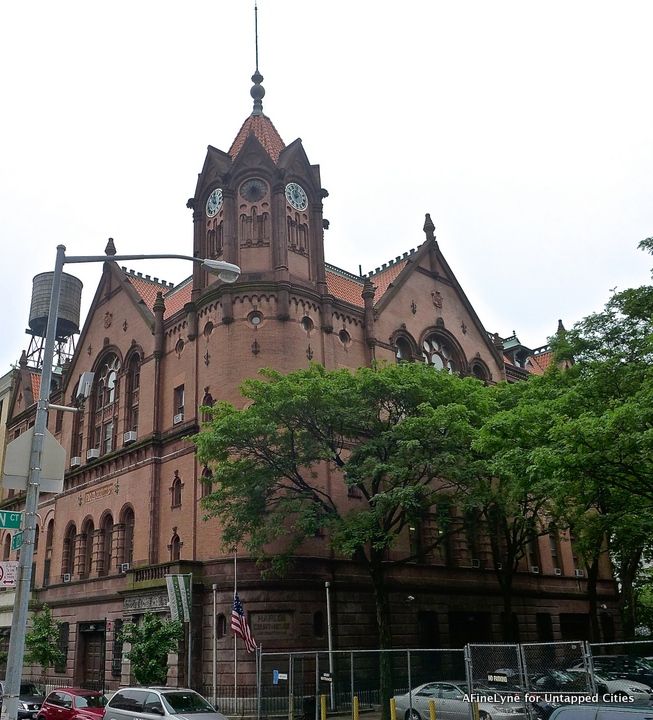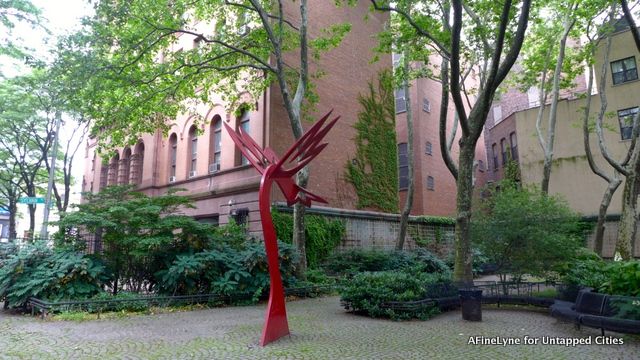100th Anniversary Great Nave Tour at the Cathedral of St. John the Divine
Celebrate the 1925 construction of the stunning nave inside the world's largest Gothic cathedral!



Built between 1891 and 1893, the Harlem Courthouse has several gables and two exterior clocks.
Lexington Avenue, the Harlem Courthouse is one of the many treasures of East Harlem. This Gothic-Romanesque Revival structure was designed and built between 1891 and 1893 by the architectural firm Thom & Wilson, who also designed the Moorish style Hampton Apartments on Perry Street in Greenwich Village, and the Criminal Courts Building on Centre Street that was demolished in 1994.
The 100′ x 100′ structure was used by the Municipal and Magistrate’s Courts, and was one of the city’s earliest county seats. Much of the building was restored during a renewal project, but the jail and former living quarters were not part of the restoration program. This part of the building was used for processing criminals and holding prisoners, who used their 40 jail cells until 1940. Suffering from mold and asbestos, this part of the building can no longer be occupied but the jail cells are still intact and archival records were retrieved with the handwritten names of prisoners in journals. The arched entryways to each jail cell have heavy plated doors with bars.

121st street entrance to the Harlem Courthouse
After restoration, the entryway on 121st street has maintained its marble mosaic floors, a stunning marble and iron spiral staircase which runs to the top of the tower, an oak door, and a window trim. It also has eight small gables with two exterior clocks. The Harlem Courthouse was designated a New York City Landmark in 1967 and added to the National Register of Historic Places in 1980.
Incorporated into the third floor courtroom walls are two murals painted by Works Progress Administration artist David Karfunkle in 1938. One was painted on a canvas and the other painted right on the plaster wall. They were named “Exploitation of Labor – Hoarding of Wealth.” Deemed inappropriate for the courtroom in its new use when it reopened in 2002, these historic murals, painted in a double-height vaulted ceiling, were hidden behind drapes.
The mural above was painted directly on the plaster wall. Over the years, it suffered great damage due to mold that can clearly be seen on the upper left hand side of the more recent picture below, with its peeling paint. Fortunately, a painter will soon begin to work on the painting and by years end, the restoration should be completed.

Paint peeling from mold damage, the mural on plaster. Source: Lorraine Brown

Usually, there are drapes covering this painting, but lucky for us, the painting was recently inspected, which means we were able to sneak a photo. Photo by Lorraine Brown
Several Art Historians including noted Harlem Historian Michael Henry Adams, have for years criticized the decision to hide the murals and are now buoyed with the knowledge that when the restoration is complete, the murals will no longer be kept behind curtains – and will be visible to all who enter the third floor courtroom.

The Entrance to Harlem Art Park on 120th Street
As well as holding a historical building, this plot of land also holds the Harlem Art Park which is part of the Historical Signs Project. When you enter the parking lot adjacent to the courthouse building, you will notice a gated garden on the south side, which can only be reached from 120th Street.

Sculpture by Artist Jorge Luis Rodriguez in 1985
The Harlem Courthouse is now in use as the Harlem Community Justice Center where family, housing and small claim civil cases are heard. There is also some office space for the NYPD. It is not open to the public unless you have business there. But fortunately for you, there is a virtual tour with the New York Correction History Society. This link was given to us by Denise Jones, the former Management Analyst at the Courthouse, who was also kind to provide us with ample history and an update on the murals.
But, if you are in the area, you can take in the majesty of the building located at 170 East 121st Street, just east of Lexington Avenue – and take a stroll through The Harlem Art Park.
For more in Harlem, check out this “light graffiti” in West Harlem, and East Harlem’s urban garden center.
Get in touch with the author @AFineLyne.
Subscribe to our newsletter